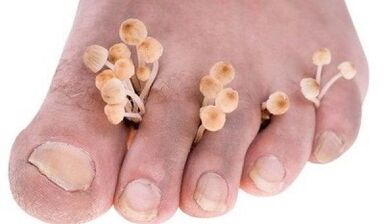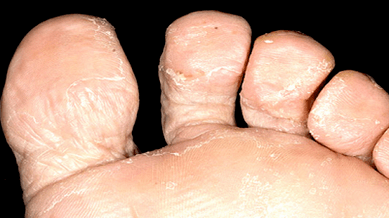Fungi between the toes is an easy disease to pick up.But getting rid of him is not easy.The disease can last for many years and is usually a bacterial infection.When the first symptom occurs, it is very important to contact a dermatologist instead of self-study.
Why fungi develop between toes

Fungi between the toes is the most common type of fungal infection, and it occurs in 70% of the population on our planet.This disease is especially common among people in constant wet or hot environments, which is usually caused by sweating due to high fatigue.These include banners, swimmers, staff at popular seminars, and more.Children suffer from illness much less frequently (no more than 4%), but the incidence rate increases dramatically during puberty.
The disease is caused by various skin fungi: Trichomonas red, thephophophytone and certain types of epidermal plants.All of these pathogens are distinguished by high survival in the environment.They can last for a long time on the bathroom and sauna, bathroom equipment, linen, shoes flooring.
You can get infected in the bathroom, sauna, pool, less on the beach.Therefore, it is very important to observe hygiene rules: use only separate towels, do not walk barefoot in public places, use individual shoes for this.
Once on the surface of the human body, mushrooms produce enzymes that break down keratin (keratinase) - proteins on the surface of the skin layer.This allows the infection to penetrate the epidermis and reproduce there.The mushroom cell membrane contains substances (behavior) that can inhibit local immunity.Manins also inhibit the reproduction of epidermal surface cells, so their detachment and purification are disturbed, leading to prolonged disease and chronic course.
Factors that lead to fungal spread and implementation
These factors include:
- Squeeze shoes that violate the blood circulation but do not exceed the air;
- engage in exercise and physical labor;
- Foot trauma, violating the skin;
- Immunity impaired, for example, in the context of diabetes, long-term administration of certain drugs (glucocorticoids), HIV infection;
- In the context of atherosclerosis of lower limbs, flat feet, etc., the blood circulation of the feet and feet invades the blood circulation.
If a person has normal general and local immunity, the fungus will not be able to overcome the protective barrier of the skin and penetrate into the skin.All factors that inhibit skin immunity allow pathogenic fungi to introduce the epidermis without any obstacles, resulting in pathological processes.
Symptoms of infection
When pathogenic fungi are introduced into the skin, mainly thin and fragile areas of the skin are affected by the interlayer gap.Here, the infection begins and can then spread throughout the foot.The first thing an infected person experiences is itching and burning between his toes.
Itching can be very intense, or it can be trivial, or even completely none, and only occurs in the context of sweating of the feet or decreased immunity.The obvious itchy, dry, painful cracks in the secondary space help increase the development of bacterial infection and suppuration processes.
Sometimes, slow bubbles appear between the fingers, filled with transparent liquids that quickly open up to form erosion.By adding bacterial infections, this type of disease can complicate the disease.
The most characteristic feature of the fungus hiding between the toes is the regular itching.These patients usually do not suspect the presence of infection and transmission.
How disease flows
Fungi can manifest in different ways.The following forms of disease are distinguished:

- Death Metamorphosis- Most common; it manifests itself in the form of itching and burning in the toes, dryness, cracks in the cracks and subsequent development of impregnation (loosening of the skin under the influence of liquids); inflammation is usually passed on to the sole surface of the foot of the foot and is almost never lagging behind.Bacterial infections are often added;
- dyshidrotot- With the emergence of slow fingers between fingers, the formation of bursts of air bubbles, the formation of erosion, the introduction of bacterial pathogens and the development of pathological processes, depending on the type of eczema, this type is scattered throughout the feet, legs and even the body;
- Erase- Flow is not paid attention; sometimes mild itching occurs.A moderate thin stripping occurred between the toes (usually between 1 and 2 or 5), which was small and not noticed by the crack patients.
Fungi in the interlayer gap can occur as an independent disease or a general manifestation of infection.As dinoflagellosis develops, fungi usually switch to the nail plate.Sometimes, it is combined with large wrinkles in the body as well as on the hands, feet and skin and skin of the skin.In the latter case, infection is usually developed according to the principle of "two feet - one brush".
How to identify infections
The diagnosis is based on a dermatologist's examination and confirmed through laboratory studies:
- Microscopy Method- Under a microscope, skin elements (scales) extracted from the lesion are examined; this is the most common method, which allows you to identify fungal infections but cannot determine the type of fungus.
- Microbiological examination- From biological materials sown in the lesions to nutrient medium; mushrooms are easy to identify, but they do not always grow under laboratory conditions, so they are usually focused only on microscopic methods.
Basic principles of treatment
To treat fungi in the two substance gaps, antifungal drugs are used.If the disease does not proceed for a long time, it will not progress and external funds will be used.In severe fungal infections, the tendency to spread or develop microbial eczema is used, and antifungal drugs with general (systemic) effects are used.
External use of antifungal agents requires preliminary preparation.Removal of pathologically altered skin elements from the skin surface: peeling, damaged places and residues from bursting bubbles.If possible, they try to alleviate inflammation and swelling in the tissue.
Execute the following procedure:
- If the tissue has obvious inflammation and swelling, a lotion is prescribed in a 2% boric acid solution, a special ointment; if not helpful, a corticosteroid ointment is specified in a brief course.
- In the presence of scales and crust, the affected areas of the body surface were lubricated twice a day with salicylic acid petroleum jelly and then bathtub with 2% soda aqueous solution.
Main treatment is only performed after cleaning.If mixed fungal-bacterial infection is suspected, use a combined ointment that includes antifungal, antibacterial and antiallergic ingredients.
Drug Therapy
The most modern drug to treat such diseases is drugs, whose active-acting substance is Terbinafine, which is part of external use products produced by various pharmaceutical companies under their trading names.These are 1% creams, gels, sprays and external uses.
This substance can easily enter the epidermis.After 4 hours of application concentration, its concentration is sufficient to inhibit important activity of infection.The concentration of the product gradually accumulates in the skin, and the concentration after treatment is many times higher than the concentration that causes fungal death.In addition, it does not penetrate the middle and deep layers of the skin, nor does it have a whole body effect on the body.One characteristic of antifungal agents is that they have antibacterial effects, thereby inhibiting the important activities of most pathogenic bacteria.Therefore, in order to treat fungal-bacterial infections, additional antibacterial treatment is not always required.
Apply cream, spray and gel to pathologically altered foot areas for 7 days every day.Usually, this is enough to fully experience all the symptoms of an infection.If necessary, dermatologists can extend the treatment process.
Because external treatments and conventional forms of common diseases are ineffective, antifungal drugs of general effect are prescribed.
As microbial eczema develops, complex treatments are developed, including antifungal drugs, antibiotics and desensitizers to reduce tissue allergic mood, inflammation and tissue edema.During severe allergies and inflammation, glucocorticoids are included in complex treatments.
Folk therapy against interface fungi
It can also be effective if folk therapy is used correctly.Traditional medicine recommends that treatment be prepared for pathologically altered areas of the foot surface before starting antifungal treatment.Cleaning is the same way as before medication.Afterwards, fixed assets are used to suppress the important function of mushrooms.
- Method 1.Twice a day for 2 to 3 weeks, infused the thighs (one third of the liter of boiling water per liter of crumbled grass) with ceylondin, and then lubricate the dry surface of the feet with a 10% propolis dose.
- Method 2.Add 20 ml of ammonia to a cup of water, moisten the bandage, wrap your fingers first, then complete your feet (do not tighten!), and leave until dry; treatment time is 14 days.
- Method 3.Foot bath with vinegar (2 liters of water - 100 ml of vinegar).They are held for 14 days a day before bedtime.After the operation, dry your legs and sprinkle with boric acid.
- Method 4.Necessary bathtub with a thread of shaft (20 g mahorka per 1 liter of boiling water, in a thermos bottle at a speed of 3-4 hours).Four weeks before bedtime every day.After the operation, the legs must dry themselves.In the morning, wash your feet with water.
- Method 5.Wash your feet with household soap and wash thoroughly between your fingers.Dry your legs and lubricate your skin with tin juice.Do this for 14 days a day.
- Method 6.Legs with 2% soda solution every day.After bathing, dry your legs with a towel and lubricate it with garlic oil.In the morning, wash with soap.Garlic oil: Mix 1 teaspoon of chopped garlic from 100 g butter until you get a uniform mass.
- Method 7.Take equal amounts of apple cider vinegar and freshly squeezed carrot juice.Apply the final mixture to the affected area of the foot skin, several times a day, for a month.
How to warn of infection
To prevent disease, you need:
- Wear rubber shale on the bathroom, sauna, swimming pool, beach;
- Never wear other people's shoes, do not use other people's towels and bathroom accessories;
- In warm seasons, wear shoes or sandals of bright natural materials that pass through the air and absorb moisture;
- To perform a pedicure, use only personal or disposable tools.
To prevent reinfection, it should be:
- Treat the inner surface of the shoe with a disinfectant solution (such as formalin solution or vinegar nature); two days after this treatment, all infectious pathogens die.
Fungi between the toes are very suitable for treatment with modern antifungal drugs and folk methods.However, it is very important to make every effort so that you won’t be reinfected, including through your own shoes and other personal use items.















